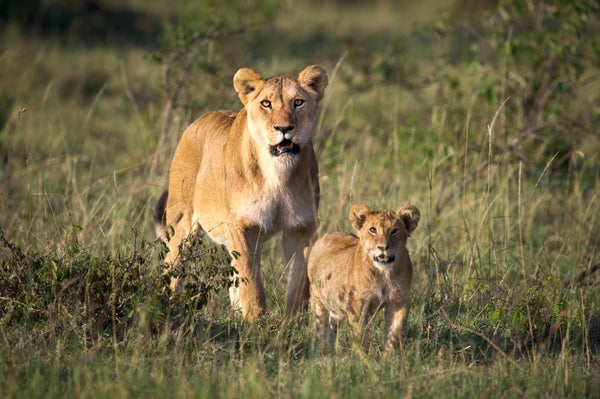This article was published in Scientific American’s former blog network and reflects the views of the author, not necessarily those of Scientific American
The news for lions (Panthera leo) just keeps getting worse. A surprising new study finds that most African lion populations have declined by 50 percent over the past 20 years. Even worse, the number of big cats is likely to shrink another 50 percent in the next two decades.
Recent surveys have already revealed that lions in Western Africa have practically disappeared, but the new study—published this week in the Proceedings of the National Academy of Sciences—finds unexpected and rapid declines in Central and Eastern Africa.
Until recently Eastern Africa was thought to be a stronghold for wild lions, says Luke Hunter, president of the wild-cat conservation organization Panthera and one of the authors of the new paper. “It turns out that was a flawed assumption,” he says. “There are excellent lion populations that are doing well in East Africa, but it turns out that they’re the exception, not the rule.”
On supporting science journalism
If you're enjoying this article, consider supporting our award-winning journalism by subscribing. By purchasing a subscription you are helping to ensure the future of impactful stories about the discoveries and ideas shaping our world today.
Hunter and his co-authors examined 47 lion populations across the continent and found that almost every single one of them has encountered rapid declines. Based on the current rate of decline , the authors calculated that lions in West and Central Africa have a 67 percent chance of halving again by 2035. The lions in Eastern Africa have a 37 percent chance of that same decline.
A few of the smaller populations may do worse than shrink. “Some are definitely doing to disappear,” Hunter says. “The human pressure is too great.”
One of the greatest threats, according to Hunter, is that the bushmeat trade has left the African savannah practically devoid of the animals that lions traditionally prey upon. “It’s a commercial endeavor, not just a subsistence one,” he says. Bushmeat is consumed by urban populations, so all of this stuff ends up on refrigerated trucks on highways and sold in cities. There are some of these iconic, immense landscapes that look terrific from the air but they’re really depauperate of lion prey.”
With so little wild prey to hunt, lions have turned to what’s left: livestock. This results in the second big threat to the big cats: retaliatory killing by rural pastoralists whose livestock have been threatened or killed by lions. “That’s pervasive and pretty severe in a lot of areas where people just find it difficult to tolerate lions,” Hunter says.
Panthera and other organizations have had some luck in reducing these retaliatory killings in some areas. Hunter points at one of their projects in northeast Namibia where the organization helped to build lion-proof corrals where people could bring their livestock at night. The safety measure not only protected the livestock, it also reduced attacks on lions. In 2013, villagers in the region killed 18 lions. That number fell to just one in 2014. No lions have been killed there so far this year.
Hunter says building corrals is just one of the tools that could be scaled up to protect lions across Africa. Other measures, he says, include increasing patrols and law enforcement to help reduce poaching. “We’ve got the solutions, but the challenge is bringing them to a massive scale,” he says.
Other successes can also serve as models for conservation. The paper found that lions are only doing well in the four countries where their populations are incredibly well managed: Botswana, Namibia, South Africa and Zimbabwe. Many of these lion populations live inside fenced-in reserves where they are protected and have lots of food, a project Hunter helped to establish in the early 1990s. “Lion populations go gangbuster in those scenarios,” Hunter says. “They’ve got area and they’ve got prey. That’s where lions do very, very well, if you can give them those two resources.”
The reserves, however, are a bit of a “double-edge sword,” Hunter admits. They have successfully created 50 new lion populations in places where they had previously been exterminated, but the lions do so well within the fences that wildlife managers sometimes need to resort to contraception or euthanasia in order to keep the lions from overbreeding.
Unfortunately, Hunter says the likelihood of moving surplus lions and establishing additional reserves—something conservationists could still do 20 years ago—seems slim today. The available habitat has already been used up. “The sad thing is there are really very few opportunities to replicate that elsewhere in Africa.”
Hunter admits that “we’ve got a huge amount of work ahead of us. It’s not just about lions. It’s about protecting these massive, iconic African landscapes. If we get it right, lions respond very quickly and African woodland savannahs can recover very quickly. They’re incredibly resilient.”
Following the infamous death of Cecil the lion at the hands of a trophy hunter, Hunter feels this may be the time to create change for the big cats. “The lion is a very iconic species,” he says. “People care about it. I hope that’s the opportunity we have now.”
Photo by Nick Garbutt courtesy of Panthera
Previously in Extinction Countdown:
